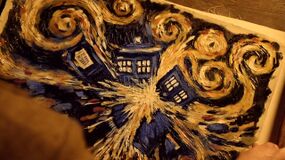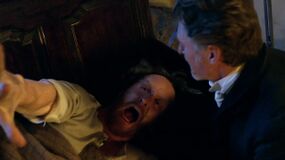Vincent van Gogh: Difference between revisions
(→Profile: remove speculation and change to facts) |
(pictures) |
||
| Line 19: | Line 19: | ||
As the Doctor and Amy prepared to leave, Vincent admitted to the Doctor that without them, his life would take a downwards turn. Before a tearful farewell, the Doctor took Vincent to 2010 to the van Gogh Museum Exhibit. At the Doctor's request, Dr. [[Black]] then described him as the greatest artist of all time, a man who turned the sad aspects of life into the most beautiful art the world had ever seen. Black's description of him as not only the greatest artist but also one of the greatest men of all time reduced Vincent to tears. He thanked Dr. Black, who for a moment realised whom he had just met. Once returned to his own time, after he thanked the Doctor and unsuccessfully proposed marriage to Amy, he stated that he had a new found respect for life. ([[DW]]: ''[[Vincent and the Doctor]]'') | As the Doctor and Amy prepared to leave, Vincent admitted to the Doctor that without them, his life would take a downwards turn. Before a tearful farewell, the Doctor took Vincent to 2010 to the van Gogh Museum Exhibit. At the Doctor's request, Dr. [[Black]] then described him as the greatest artist of all time, a man who turned the sad aspects of life into the most beautiful art the world had ever seen. Black's description of him as not only the greatest artist but also one of the greatest men of all time reduced Vincent to tears. He thanked Dr. Black, who for a moment realised whom he had just met. Once returned to his own time, after he thanked the Doctor and unsuccessfully proposed marriage to Amy, he stated that he had a new found respect for life. ([[DW]]: ''[[Vincent and the Doctor]]'') | ||
Soon afterwards, however, Vincent came under the care of Dr [[Gachet]] as his fears were realised: his mental health further deteriorated. During his final year of life, he was affected by the transmission of the warning signal of [[Stonehenge]] about the [[Pandorica]] and was plagued with visions of [[the Doctor's TARDIS]] exploding. He painted the subject in ''[[The Pandorica Opens]]'', which was ferried for thousands of years, ending up in [[River Song]]'s possession. ([[DW]]: ''[[The Pandorica Opens (TV story)|The Pandorica Opens]]'') | [[File:The_pandorica_opens-van_gogh.jpg|thumb|left|The Pandorica Opens]]Soon afterwards, however, Vincent came under the care of Dr [[Gachet]] as his fears were realised: his mental health further deteriorated. During his final year of life, he was affected by the transmission of the warning signal of [[Stonehenge]] about the [[Pandorica]] and was plagued with visions of [[the Doctor's TARDIS]] exploding. He painted the subject in ''[[The Pandorica Opens]]'', which was ferried for thousands of years, ending up in [[River Song]]'s possession. ([[DW]]: ''[[The Pandorica Opens (TV story)|The Pandorica Opens]]'') | ||
After having returned Vincent to his own time, the Doctor and Amy returned to the exhibit in 2010. They discovered that, despite their best efforts, Vincent still killed himself the following year (possibly in part due to his visions of the Pandorica opening). Amy was distraught at having failed to change Vincent's life, but the Doctor assured her that they had made some difference. At the museum they saw that the ''Sunflowers'' inspired by Amy in 1890, had been changed and dedicated "for Amy". ([[DW]]: ''[[Vincent and the Doctor]]'') | [[File:VincentVanGogh.jpg|thumb|right|Vincent is extremely troubled during his final months]]After having returned Vincent to his own time, the Doctor and Amy returned to the exhibit in 2010. They discovered that, despite their best efforts, Vincent still killed himself the following year (possibly in part due to his visions of the Pandorica opening). Amy was distraught at having failed to change Vincent's life, but the Doctor assured her that they had made some difference. At the museum they saw that the ''Sunflowers'' inspired by Amy in 1890, had been changed and dedicated "for Amy". ([[DW]]: ''[[Vincent and the Doctor]]'') | ||
==Works== | ==Works== | ||
Revision as of 19:44, 21 June 2010
Vincent van Gogh was a famous Dutch painter of the late 19th century. During the latter part of the century, he lived in Montmartre for a period of time. Van Gogh suffered from intense mental illness, including bipolar disorder and bouts of anxiety. He died at the age of 37 from a self-inflicted gunshot wound. Although largely unknown at the time of his death, he went on to be regarded as one of the greatest painters of all time.
Profile
Vincent van Gogh was sent to France by his brother Theo in order to gain experience from possibly meeting other painters of his time. However, there he eventually ended up alone, and gained a reputation among the locals of Auvers-sur-Oise as a madman and drunkard. He tried to sell his paintings, without success, in order to buy drink.
Meeting the Doctor
Van Gogh encountered the Doctor and Amy Pond in 1890, commenting on Amy's beauty before accepting her offer to share a bottle of wine. However, they were interrupted by several villagers, as a young girl had been found dead. When the Doctor, van Gogh and Amy attempted to help the girl, one of the villagers blamed Vincent for the accident and drove him away, throwing rocks. Vincent allowed the Doctor and Amy to stay in his home which was cluttered with paintings he viewed as worthless, unaware that they would eventually be some of the best-selling paintings of all time. Later, when Amy was attacked by the Krafayis, it was revealed that Vincent could see it, allowing him to save both Amy and the Doctor. Later on, with a little help from Amy and the Doctor, Vincent agreed to help them stop the Krafayis from killing anyone else. However, before they left for the church, Vincent had a breakdown, upset because, like everyone else before, both Amy and the Doctor would leave and he would be forgotten and alone. When the Doctor tried to empathise, he became angry and ordered him out. After calming down, Vincent once again decided to help the Doctor, stating that if Amy Pond could march on, so could he. On the walk to the church he showed he could tell Amy is heartbroken, though she herself cannot. When they reach the church he begins to paint, and after several hours spots the creature in one of the windows. When the Doctor leaves to confront the Krafayis, Vincent sees the beast noticing him and follows, allowing the Doctor, Amy and himself to hide. Whilst hiding from the Krafayis, the Doctor notices that it is blind, and was scared being all alone on Earth. When the Krafayis charged, Vincent attempted to ward off the creature but it ended up impaling itself and dying, for which he showed great remorse. He genuinely sympathised with the creature's plight, as both were mistreated by their peers due to their different forms of vision.
As the Doctor and Amy prepared to leave, Vincent admitted to the Doctor that without them, his life would take a downwards turn. Before a tearful farewell, the Doctor took Vincent to 2010 to the van Gogh Museum Exhibit. At the Doctor's request, Dr. Black then described him as the greatest artist of all time, a man who turned the sad aspects of life into the most beautiful art the world had ever seen. Black's description of him as not only the greatest artist but also one of the greatest men of all time reduced Vincent to tears. He thanked Dr. Black, who for a moment realised whom he had just met. Once returned to his own time, after he thanked the Doctor and unsuccessfully proposed marriage to Amy, he stated that he had a new found respect for life. (DW: Vincent and the Doctor)
Soon afterwards, however, Vincent came under the care of Dr Gachet as his fears were realised: his mental health further deteriorated. During his final year of life, he was affected by the transmission of the warning signal of Stonehenge about the Pandorica and was plagued with visions of the Doctor's TARDIS exploding. He painted the subject in The Pandorica Opens, which was ferried for thousands of years, ending up in River Song's possession. (DW: The Pandorica Opens)
After having returned Vincent to his own time, the Doctor and Amy returned to the exhibit in 2010. They discovered that, despite their best efforts, Vincent still killed himself the following year (possibly in part due to his visions of the Pandorica opening). Amy was distraught at having failed to change Vincent's life, but the Doctor assured her that they had made some difference. At the museum they saw that the Sunflowers inspired by Amy in 1890, had been changed and dedicated "for Amy". (DW: Vincent and the Doctor)
Works
- The Doctor was given a sketch of the Krafayis by van Gogh to identify the creature. It is presumably still in his TARDIS.
- Craig Owens had a postcard for the van Gogh exhibition at the Musée d'Orsay on his fridge. (DW: The Lodger)
- Peri Brown was able to identify unknown works by him. (DWM: Changes)
- Harry Sullivan attended an exhibition of van Gogh's work and met a young woman named Samantha there. Sullivan was later linked to the van Gogh Appreciation Society (a front for the European Anarchist Revolution) and its leader, Zbigniew Brodsky. (TC: Harry Sullivan's War)


